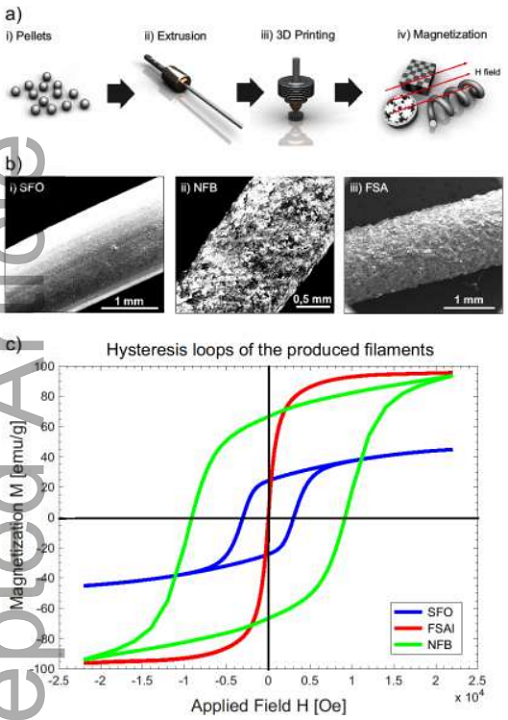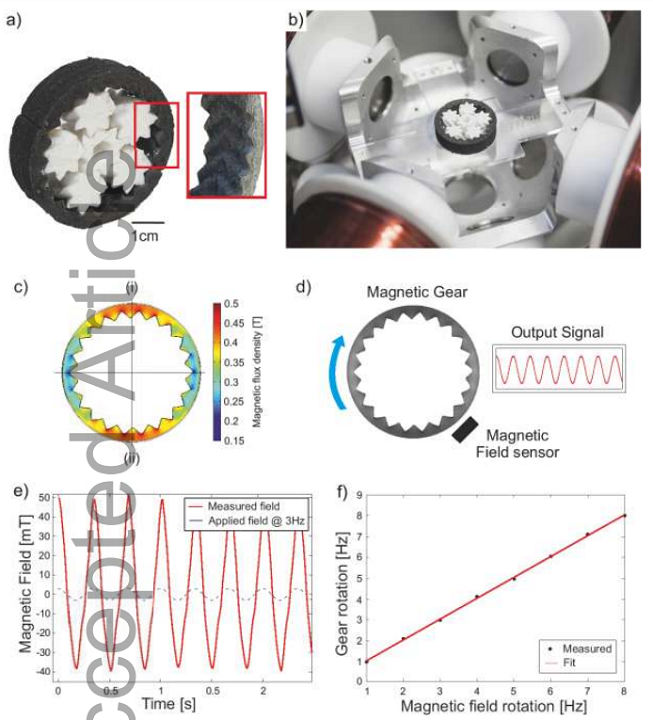Investigating FDM 3D Printed Thermoplastic-Bonded Magnetic Composite Materials
While magnetic materials are pretty important when it comes to creating and implementing novel technologies, like 3D printing, it’s not easy to integrate or tune them in complicated designs, because of constraints in conventional manufacturing methods. A team of researchers from ETH Zurich, the Universitat Autònoma de Barcelona, and ETH Zurich spin-off company Magnes AG published a paper, titled “3D Printing of Thermoplastic-bonded Soft-and Hard-Magnetic Composites: Magnetically Tuneable Architectures and Functional Devices,” that explains their investigation into creating polymer composites – using a customized FDM 3D printer – that possess magnetic properties and tailored geometries.
“Recently, there has been an interest in printing hard magnets, owing to the significance of these materials in a wide range of applications. Hard-magnetic components are ubiquitous in industrial equipment and consumer goods. However, the processability and integration of these materials has hampered further development of advanced magnetic technologies, which are crucial in the fields of robotics, renewable energy, aeronautics or automotive engineering,” the researchers explained.
“Current manufacturing methods for these materials such as injection molding and sintering face several obstacles, particularly in the production of complex geometries.”

Figure 1: a) Illustration of the 3D printing procedure. b) Composite filaments of i) SFO/PA12, ii) NFB/PA12, iii) FSA/PA12; c) Hysteresis loops of the produced filaments. FSA/PA12 exhibiting the softest magnetic properties with a coercivity of 24 Oe, followed by SFO/PA12 with a coercivity of 2910 Oe and NFB/PA12 with a coercivity of 8010 Oe.
By using 3D printing, it’s possible to make high-performance, composite magnets that are patterned in “arbitrary shapes and architectures” and made specifically for certain applications, which helps keep costs down.
“In this work, we investigate the manufacturing of 3DP thermoplastic–bonded magnetic composites (TBMC), with both tailored geometries and magnetic properties, using a customized fused deposition modeling (FDM) 3D printer,” the researchers wrote. “The composites are made of polyamide and contain magnetic particles of different sizes and magnetic behavior.”
The team created and tested a total of three TBMC filaments, each with a different magnetic property. The next step was showing how the feedstock magnetic materials’ specific properties were preserved in the final structure, and then the researchers explained how to adjust its magnetic behavior by using a double nozzle setup to 3D print parts with varying “magnetic attributes.”
“To demonstrate the versatility of our double–nozzle customized FDM printer, we also fabricated 3D structures made of non-magnetic and magnetic parts,” the researchers explained. “To this end, we print planetary magnetic gearboxes with different configurations, and we demonstrate their potential applicability as magnetic rotary encoders (MRE).”
MREs, which position and control the motion of industrial robotic tools, are made up of a magnetic ring, or disc, where “a magnetic pattern of alternating poles is written.” Additional sensor components aren’t necessary when the magnetic material is 3D printed directly onto the rotary shaft, and more materials can be used.

Figure 2: a) 3D printed structures: i) the Eiffel Tower at a scale of 1:1200 printed with NFB/PA12; ii) complex helical structure combined with a conical body printed with SFO/PA12; iii) Two 3D printed NFB/PA12 gears with perpendicular magnetization to their axis; v) Magnetic helix 3D printed from NFB/PA12 and a water-soluble support material; iv) and vi) 3D printed ninja stars from SFO/PA12. b) Shows a disc and a rectangular 3D printed structure and their corresponding SEM images. From the SEM image, each individual layer can be observed. The thickness of each layer was approximately 100 µm. c,i) ETH logo printed with SFO/PA12 TBMC on a PLA surface, and c,ii) three magnetic blocks connected with nonmagnetic PLA hinges. c,iii) Manual bending test of the structure to assess the adhesion of the magnetic material on the substrate. d,i) a 3D printed cylinder, and d,ii) the magnetic characterization procedure. d,iii) Comparison of the measured flux densities B generated by the 3D printed cylindrical magnets with an analytical model.
The researchers used three commercially available polyamide (PA)-based magnetic composite pellets for their experiments, and optimized the extrusion parameters when producing each one: Nd2Fe14B (NFB/PA12), Fe6.72Si1.27Al (FSA)/PA12, and SrFe12O19/PA12 (SFO/PA12). The composites, and the final structures, were tested for features like surface morphology, magnetic properties, adhesion, and thermal energy, among others.
“A powerful feature that can be exploited using a dual nozzle process is illustrated in Figure 3a, which shows 3D printed structures made of magnetically dissimilar TBMC parts,” the researchers wrote. “By combining TBMCs with different magnetic properties, the overall magnetic behavior can be customized. For example, it is possible to adjust the coercivity, the saturation magnetization, or the remanence of the final printed structure.”

Figure 3. 3D printed structures made of magnetically dissimilar TBMC parts. a,i) illustration of a disc composed of two layers, a,ii) 3D printed disc where the bottom layer is made of a hard-magnetic TBMC and the top layer of a soft-magnetic TBMC. This strategy can be used to increase the saturation magnetization of a hard-magnetic component without excessively compromising its coercivity and remanence. a,iii) resulting hysteresis loop of the 3D printed disc composed of two layers. b,i) illustration of a crisscrossed patterned cuboid, b,ii) 3D printed crisscrossed patterned cuboid consisting of hard-magnetic TBMC stripes alternated with soft-magnetic TBMC ones. b,iii) shows the resulting hysteresis loop of the crisscrossed structure made of two different magnetic composites.
Using this approach, the team 3D printed a disc with a soft-magnetic TBMC top layer and hard-magnetic TBMC bottom layer, and a crisscross patterned cuboid with alternating hard-magnetic and soft-magnetic TBMC stripes.
“By combining two different TBMCs, a semi-hard magnetic material with a slightly constricted-type hysteresis loop is obtained, suggesting an influence of interparticle magnetic dipolar interactions,” the researchers explained. “Note that structures made of the same composite but with different shapes can exhibit differences in their magnetization loops mainly due to shape anisotropy.”
A dual nozzle extruder also makes it possible to 3D print self-contained mechanisms, with several moving parts, without having to assemble them separately – a major application in the field of gear technology. The researchers used their custom 3D printer to fabricate a magnetic gear system out of both magnetic and nonmagnetic material. They performed Finite Element Method simulations on the system in order to analyze its magnetization behavior.

Figure 4. a) 3D printed gearbox with helical teeth profile. b) Gearbox arranged inside magnetic manipulation setup. c) FEM simulation of the magnetic corona’s magnetic field density. d) Magnetic encoder arrangement used to measure the rotations of the gear. e) The applied magnetic rotational field and measured field as a function of time at a magnetic rotational frequency of 3 Hz. f) Rotating speed of the gear as a function of the applied rotational magnetic frequency.
“For our experiment, the maximal applied rotational frequency (cut-off frequency) was measured at 28 Hz. Above this frequency, the gearbox starts to stutter and the motion changes from a revolving to a shaking motion. The cut-off frequency and the shaking motion are related to the interplay between rotational drag and the alignment of the magnetization of the gear with the external magnetic field. Above 28 Hz, the drag generated by the gears is sufficient to make the magnetic gear lag back. The induced lag allows the external magnetic field to overtake the gear itself, causing the torque on the magnetic gear to switch direction back-and-forth, producing the rocking motion of the gearbox,” the researchers explained.
Because 3D printing offers such high complexity, the researchers were able to achieve multiple TBMC complex shapes and tunable customized magnetic properties. Their work showed that their TBMC materials can transfer magnetic properties to the 3D printed structure without any deterioration.
“The use of 3DP for magnetic applications represents a leap towards on-site versatile fabrication of complex magnetic devices, which would otherwise be unfeasible with conventional manufacturing techniques,” they concluded.
Co-authors of the paper were George Chatzipirpiridis, Simone Gervasoni, Cedric Fischer, Olgaç Ergeneman, Eva M. Pellicer, Bradley J. Nelson, and Salvador Pané.
Discuss this and other 3D printing topics at 3DPrintBoard.com or share your thoughts below.
Subscribe to Our Email Newsletter
Stay up-to-date on all the latest news from the 3D printing industry and receive information and offers from third party vendors.
Print Services
Upload your 3D Models and get them printed quickly and efficiently.
You May Also Like
AMT Shakes Up 3D Printing Market with Affordable, High-Performance Post-Processing Consumables
Additive Manufacturing Technologies (AMT), a global leader in automated 3D printing post-processing, is launching a new line of consumables that promises to significantly reduce operational costs for additive manufacturing users....
The Bambu Lab 3D Printing Platform… or Trapdoor?
Bambu Lab began as a completely closed 3D printing system, where the printer, software, and materials all functioned well but were exclusively from the company itself. This approach mirrored Formlabs,...
2025 Renault 5 E-Tech Electric Is Latest Car with 3D Printed Accessories
Due to the required numbers, additive manufacturing (AM) has struggled to make significant inroads into vehicle interiors in meaningful numbers—at least as far as public knowledge is concerned. Typically an...
BMW Completes Project to Automate Plastic 3D Printing
After a three-year journey to efficiently scale polymer 3D printed part production, the POLYLINE project has concluded. This endeavor, headquartered at BMW’s Additive Manufacturing Campus, pooled the expertise of EOS,...






























